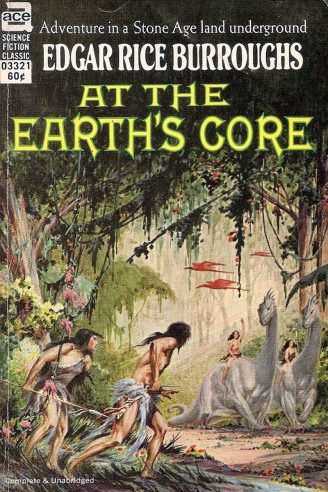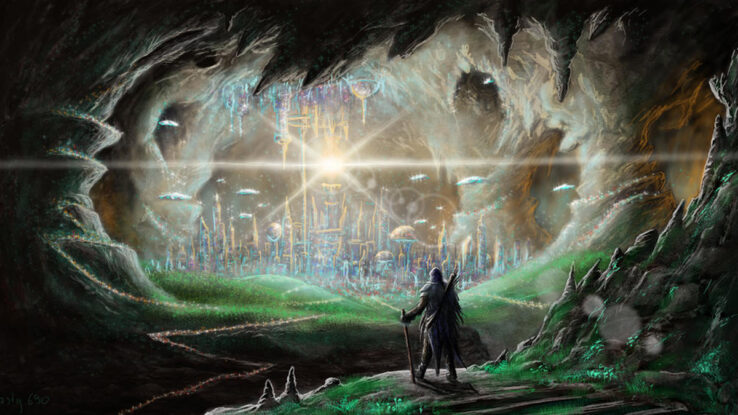The idea that the Earth is hollow has been disproven for centuries, yet, not unlike the Nazis who have made their home there in dieselpunk fiction, it refuses to die. It returns as myth, pseudohistory, fiction or hoax, most recently in the Hollywood movie Godzilla vs. Kong, where Hollow Earth is home to all sorts of monsters.
The Ancient Greeks and early Christians placed the underworld or Hell in the interior of the Earth. Ancient Tibetans imagined a much nicer place: they thought the spiritual kingdom of Shambhala could be found somewhere in the middle of the planet. Other civilizations had similar myths.
More recently, John Cleves Symmes Jr., an American Army officer, suggested in 1818 that the Earth’s interior could be accessed through holes at the North and South Poles. This isn’t true either (people have been there), but it has become a staple of Hollow Earth mythology.


When William Fairfield Warren argued in Paradise Found — The Cradle of the Human Race at the North Pole (1885) that humanity had descended from a continent called Hyberborea in the Far North, this got mixed up into the Hollow Earth story.
In Willis George Emerson’s The Smoky God, or A Voyage Journey to the Inner Earth (1908) and Vladimir Obruchev’s Plutonia (1915), the subterranean world is warmed by an interior sun. Obruchev’s is named after the Roman god of the underworld, Pluto, and has dinosaurs too.
These three inventions — a race of ancient supermen living inside the planet, side-by-side with dinosaurs and warmed by an interior sun — have become Hollow Earth tropes.



The supermen angle means that in dieselpunk, there is often a Nazi connection.
In the real world, Nazi Germany undertook one Antarctic expedition, in 1938-39, and claimed what it called New Swabia for the Reich. In dieselpunk, this is either the start of a German effort to colonize the South Pole (also see Nazis in Antarctica) or the first attempt to contact Hollow Earth.


Taking his cue from Warren and his Hyberborea under the Earth, Max McCoy, in Indiana Jones and the Hollow Earth (1997), puts our hero on a chase of Nazi agents to the legendary Ultima Thule under the Arctic ice.
The 2006 role-playing game Hollow Earth Expedition is set in the 1930s and features two factions: a Terra Arcanum dedicated to keeping the Hollow Earth secret and the Nazi-affiliated Thule Society that is hoping to retrieve powerful weapons from it. This Hollow Earth is populated by dinosaurs.



In Mick Farren’s Underland (2002), Nazis have fled into Hollow Earth following World War II and allied there with the descendants of an ancient race of sentient reptiles.
This comes back in Iron Sky: The Coming Race (2019, our review here), where Hollow Earth is the home of the alien Vril, who arrived on Earth at the time of the dinosaur and have been secretly guiding human history ever since, including by posing as Nazis. The name of their capital is Agartha, in esoteric literature a Shambhala-like kingdom at the center of the Earth.

The best-known example without Nazis (there are some) is Jules Verne’s Journey to the Center of the Earth (1864), in which a German professor and his nephew travel down an Icelandic volcano and encounter various prehistoric species still alive in vast underground caverns before emerging in southern Italy.
Verne’s novel has been adapted into several movies, notably in 1959 and 2008, and it has inspired other authors, including Edgar Rice Burroughs, whose Pellucidar series, starting with At the Earth’s Core (1914), additionally borrowed the interior sun from Obruchev.



In Carl Barks’ “Land Beneath the Ground!” (1955), Scrooge McDuck and his nephews discover an underground civilization of creatures who look like bowling balls with arms and a head, but no legs. The same creatures make an appearance in Don Rosa’s “The Universal Solvent” (1995), when the Ducks travel to the center of the Earth in Jules Verne-style.


In Rudy Rocker’s The Hollow Earth (1990), a teenager befriends Edgar Allan Poe in 1836 and the two enter Hollow Earth through a thousand mile-deep hole at the South Pole.
Hellboy creator Mike Mignola co-wrote the short story Hollow Earth (2002) with Christopher Golden and Tom Sniegoski — art by Ryan Sook and Curtis Arnold — in which agents of the Bureau for Paranormal Research and Defense journey into caverns inside the Earth and discover… Hyperboreans.
In the Tunnels books (2005-13) by Roderick Gordon and Brian Williams, multiple civilizations coexist in a Hollow Earth warmed by an interior sun.



Various artists have given their own interpretation of Hollow Earth. Here are examples by Claudio Bergamin, Joakim Ericsson, Ivan Khmel and Rastislav Kubovič.













3 Comments
Add YoursThe world can’t be hollow if it’s flat, and it has to be flat so as to not fall off the back of the turtle.
Now you can have massive lunar lava tube caves due to much lower gravity-miles across…I’m also of the opinion that if terraformed and air filled, animals could grow quite large,..with gene-spliced dragons and other forms of flight possible. There was even a paper about nuking a hole through the Moon. On Earth…there may be fossils in long subducted plates. Most interestingly–there was a magazine a couple of decades ago that said that…if you could somehow suspend a big asteroid upon diamond pillars…you might be able to sit upon the lower surface…because that rock’s gravity is dominant near the surface…also more do-able on the Moon, if true. SMU detected a linear quake in 1993 that could have been a stranglet or small black hole passing through. A tiny enough black hole could orbit our core beneath our feet almost as if our solid planet was hollow…due to scaling.
You left out this long forgotten gem.
https://letterboxd.com/film/journey-to-the-center-of-the-earth-1993/